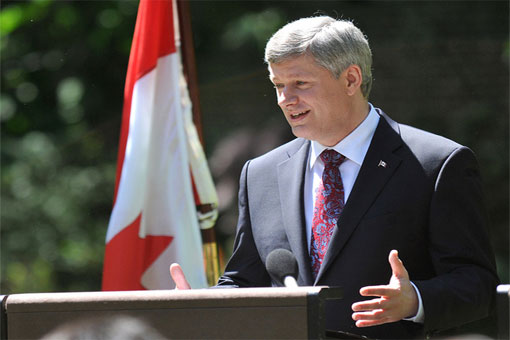The defeat of Prime Minister Stephen Harper’s minority Conservative government in the House of Commons on March 25 has set the stage for a federal election on May 2. But voter fatigue—this is the fourth election in seven years—may explain why Canadians are not yet consumed by election fever.
The Conservatives’ downfall came after opposition parties declared the government “in contempt of Parliament”—a charge unprecedented in Canada’s history. The reason: failing to detail the costs of 18 crime bills, 65 state-of-the-art stealth fighter jets from Lockheed Martin and large corporate tax cuts. Opposition members of parliament (MPs) complained that they had to vote on legislation without knowing the real cost of the measures.
The chaotic week ended with Harper asking Governor General David Johnston, the representative of the Queen in Canada’s parliamentary democracy, to dissolve Parliament.
However, according to Nik Nanos, president of the Ottawa polling firm Nanos Research, it looks like Canada may end up where it started: a minority conservative government with the Liberal Party of Canada as the main opposition party. “We could have a variation of the last two elections so it’s difficult to get excited,” he says. Since the election has been called, Nanos’ polls show the Conservatives holding an 8 to 14-point advantage over their closest rival, the Liberals.
The week of April 5, the Tories were polling at 39.8 percent of public support followed by the center-left Liberals at 30.2 percent and the left-leaning New Democratic Party at 16.5 percent. The Bloc Québécois, a pro-independence party that sits in the House of Commons but only runs candidates in the province of Québec, is ahead in all major polls in Québec.
The question is, can Harper’s team hold on to its lead?
In past elections, it has not been able to do so. Support has evaporated as soon as there was the possibility of a Tory majority government. Voters, it seems, get cold feet and change their minds in the ballot box. Harper is well-appreciated in the Conservative’s Alberta stronghold, in some areas of British Columbia on the West Coast and in other pockets of the country. But for some, his team is perceived as being too right-leaning on social issues, and Harper himself is seen as too cold and controlling.
That means the big battlefield will be in Ontario, which holds 106 of the 308 seats in the House of Commons.
That may translate into a majority Conservative party. “I suspect that the level of voter fatigue in Canada to go to the polls has been underestimated,” says Luc Dupont, professor of communications at the University of Ottawa. “The easy solution is to say I don’t want to go back to the polls in a year or so, so let’s vote for the Conservative Party.”
Another factor that will play into the hands of Harper’s conservatives is the fact that Canada has weathered the global recession relatively well.
“As long as the theme of the campaign is the economy, Harper has the advantage, adds Dupont. If the theme is transparency, [Michael] Ignatieff has the advantage.” Ignatieff is the head of the Liberal Party.
Harper has been showcasing Canada’s economic performance from day one. As part of his platform, he’s campaigning on his March 22 budget. It’s a “clever move” says Dupont, because he’s inviting Canadians to look at his budget promises. “And he sends the message, oh, by the way, we were defeated on this budget.”
With the election call, the budget was never passed in the House of Commons. It pledged funds for volunteer fighters, the military, seniors, and families and promoted job creating measures. Corporate tax cuts were kept and promises made to eliminate the C$50 billion (US$52.14 billion) federal deficit by 2015.
Although publicly, Harper has repeated he didn’t want an election, the Conservatives have been in campaign mode for a couple of months. They’ve been running negative television ads depicting their main rival, Liberal leader Ignatieff, as a stranger to Canada, an intellectual disconnected from the average Canadian. Born in Toronto, Ignatieff, an author and journalist, spent 30 years abroad teaching at Oxford and Harvard before returning to Canada in 2005 to lead the Liberal Party.
In his first election campaign, Ignatieff is trying to shed that image. Last summer, he toured the country flipping burgers and hot dogs and hugging babies. Dupont says he’s made a conscious effort not to appear “as the professor who is a bit cold, a bit boring, a bit introverted.”
And it’s paid off.
Hoping to bring voters on his side, Harper is also pouncing on the idea of a Liberal-led coalition government with the New Democratic Party (NDP) and the Bloc Québécois, an idea that appeals to Quebeckers but sends shivers down the spines of voters in the Western provinces and elsewhere. After the 2008 election, then-Liberal leader Stéphane Dion, saying the government didn’t have the support of the House of Commons, worked out a deal with the NDP (and supported by the Bloc) to form a coalition government to replace Harper’s government. The coalition failed and Canadians were spared another election.
For Nanos, all this talk about a dangerous coalition is good strategy for the Conservatives because it has “knocked off” the map more damaging themes such as transparency, ethics and accountability, Harper’s trademark. He won on those issues in the 2006 election.
But his government now faces scandals. Four Tory officials, including two sitting senators, face election fraud charges. Harper’s former close advisor, Bruce Carson, has a criminal record for fraud. Harper says he would never hired him had he known the full extent of his criminal record but he did know Carson had been in trouble with the law.
The trust factor may come back to haunt Harper.
While campaigning in Winnipeg, Manitoba, NDP leader Jack Layton came out swinging, saying those scandals were proof Harper can’t be trusted. Presenting himself as the champion of Canada’s public health care system, Layton is trying to seduce voters by promising incentives for families, soldiers, and the elderly. But the main problem for the New Democrats is that they have never formed a government at the national level.
Ignatieff has unveiled a C$8 billion (US$8.34 billion) platform over two years designed to make life more affordable for families, students, seniors and people looking after ailing loved ones, all issues that appeal to NDP supporters. He also promised homeowners a new home renovation tax credit for green energy-efficient renovations.
With a short 36-day campaign, the focus now is on courting those unmotivated voters, and all four party leaders are hoping to sway the election during the two high-profile television debates. The English debate will be aired on April 12 and the French debate on April 13. Although Harper initially agreed to a one-on-one debate with Michael Ignatieff, he has since backtracked to avoid making any costly mistakes.
To stay ahead, Harper has to make sure his campaign bores voters to sleep by “not making waves,” Nanos adds. So far, so good.






